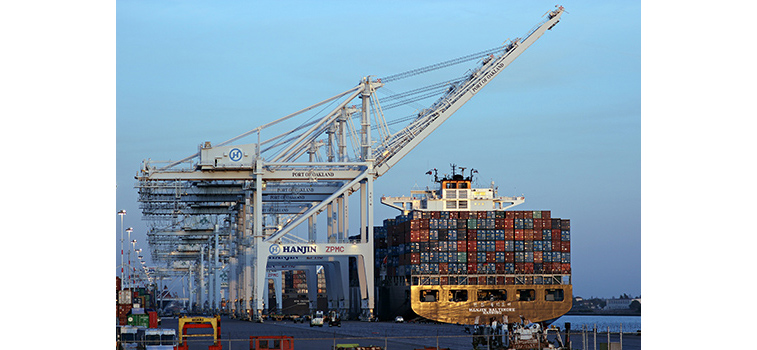Port of Oakland containerized import volume for 2017 is outpacing 2016 totals despite a decline last month.

The Port of Oakland reported that imports were up 3.8 percent through the first 11 months of 2017. Photo courtesy of Port of Oakland
BY PATRICK BURNSON
Published: January, 2018
Port of Oakland containerized import volume for 2017 is outpacing 2016 totals despite a decline last month. The port reported that imports were up 3.8 percent through the first 11 months of this year.
Gains came mostly from the summer-autumn peak season when retailers replenished holiday inventories, the port said. The port said that import volume in November declined 1.6 percent from the same month a year ago. Import volume had risen 12.6 percent in September and 6.4 percent in October.
Total 2017 container volume—imports, exports and empties—was up two percent through November, spokespeople added.
The Wine Trade in Oakland
In his latest newsletter column produced by the Pacific Merchant Shipping Association (PMSA), noted economist Jock O’Connell said that “every port is unique,” and while all ports face common challenges, the Port of Oakland is still in the business of catering to local markets.
Although Oakland is currently the nation’s eighth-largest port in terms of total containers handled, the preponderance of its trade serves the needs of the surrounding Northern California region. O’Connell’s report is essential reading for anyone interested in Bay Area port business:
“On the export side, Oakland is the principal gateway for the export of agricultural products from an arc of counties stretching from Sonoma and Napa to the north, through the Central Valley, and back through Monterey and Santa Cruz. This region is arguably the most valuable agricultural real estate on the planet.
“Not surprisingly, the Port of Oakland’s top ten export commodities (by weight) include rice, nuts, citrus fruit, grapes, forage products, meats, tomatoes and wines in addition to a selection of scrap and waste commodities. By contrast, Oakland handles very little of the advanced-technology products for which the San Francisco Bay Area is chiefly famous. Virtually all of Northern California’s technology exports travel by air to overseas destinations.
“But Oakland’s real distinction lies on the import side, where it serves not just a regional market but a market that is richly emblematic of the Bay Area lifestyle.
“By weight, Oakland’s top two containerized imports are wine, followed immediately by the glass containers in which to pour wines. (Casks and barrels, about 90 percent of which come from France, are somewhat lower on the port’s import list.)
“Also among Oakland’s top imports are such Trader Joe’s or Whole Foods staples like coffee, beer, preserved fruits and nuts and bottled water (with Italy, Fiji and France accounting for over 90 percent of that liquid trade).
“Wine imports may arrive at the Port of Oakland in bottles, but the bulk of the trade involves bulk wines shipped in formats such as plastic bladders that can hold upwards of 24,000 liters. That’s enough to fill 32,000 standard bottles or 2,667 cases.
“Still wines in conventional bottles continue to account for about 41 percent of the port’s wine imports, while bottled sparkling wines such as Champagne hold a roughly 6 percent share. But generally lower quality wines shipped in bulk represent 53 percent of wine imports through Oakland. Chile, Australia, Italy, Argentina and New Zealand have lately been the principal sources of the East Bay port’s wine imports.”
Prologis Adds Former Postal Service Property
Across the Bay, San Francisco-based Prologis recently acquired the Bayshore property, which had been owned by a local partnership and leased to the U.S. Postal Service for over 20 years. When the facility closed and the owners realized their exposure to extensive capital and releasing costs, the Prologis team negotiated an off-market purchase at a 30 percent discount to replacement cost.
Favorable pricing, the property’s strategic infill location, lack of competitive product and easy access to both downtown San Francisco and SFO were all compelling offsets to leasing and capital risks. The property had been vacant for more than a year at the time of acquisition. The postal service had made many alterations that were not reusable and the existing configuration lacked adequate docks and functional storage areas. In addition to these physical challenges, new industrial use required administrative approval from the city because the building had been vacant for more than 12 months.
Prologis started marketing the property immediately using architectural renderings that envisioned a range of ways to make the space more functional. Simultaneously, Prologis initiated the planning process for a speculative renovation. When a lease deal with the San Francisco MTA materialized, Prologis made improvements to meet the user’s specifications and stabilized the property ahead of the original leasing schedule, adding over 35 percent to the value of the property after accounting for renovations.
Local knowledge and relationships enabled Prologis to identify an off-market opportunity. Purchasing well-located vacancies at the right price can drive opportunistic returns well beyond stabilized asset acquisitions.
Patrick Burnson is the executive editor of Logistics Management. www.logisticsmgmt.com

